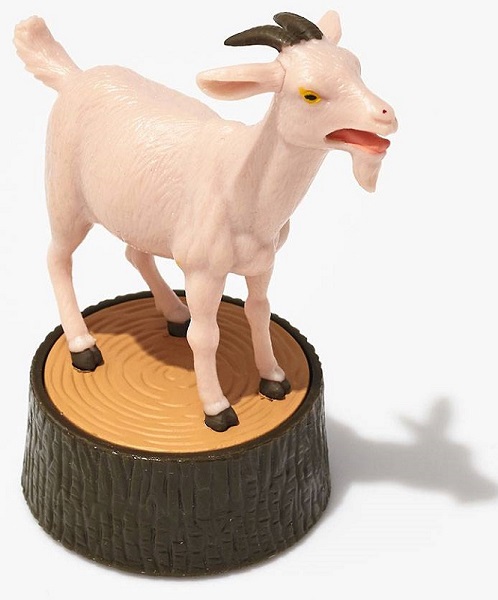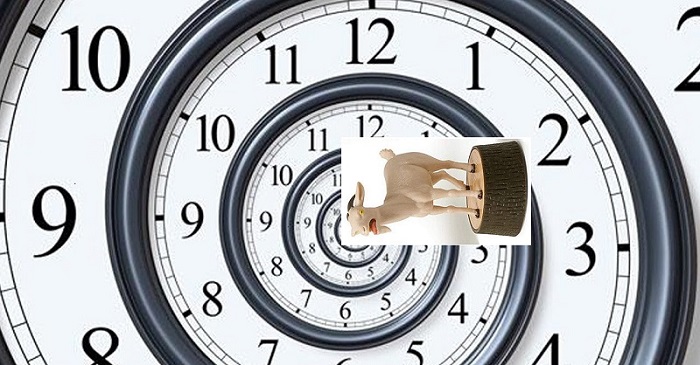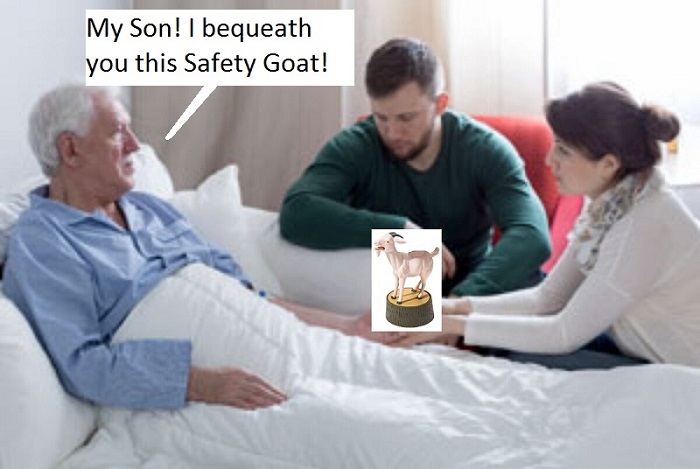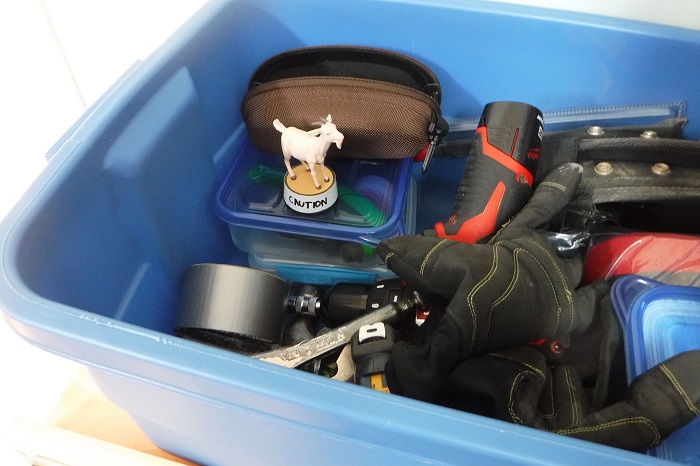
Caution, The Safety Goat.
Let's Adore Jesus-Eucharist! | Home >> Varia >> Bachelor's Kit

Caution, The Safety Goat.
What is the most important tool in my toolbox? Of course, it's "Caution, the Safety Goat"!
Seriously, the most important tool in any toolbox is your head: your head filled with skills, especially the skill of working safely. The idea of a ridiculous plastic toy that screams when you push the button, with a card glued to it containing actual safety information, doesn't take up much space in your toolbox, and might occupy enough space in your memory to save your life or prevent a serious injury.
(Terminological note: all this originated in a YouTube video by "AvE", and he uses the expression "Prudence, the Safety Goat", but Prudence is the most important human virtue, upon which our entire quest for happiness depends. "Caution", the virtue of avoiding traps and pitfalls (in our case, hazardous situations in the workplace) is only a small part of Prudence.)

A Safety Goat to make you travel through time!
[Source]
So what exactly is "Caution", and how to we acquire it? How can we detect dangerous situations before we are actually in them? I don't know for sure, but I'd guess there are at least three components to Caution: the step-back reflex, the pattern-matching search, and a sense of smell.
The first component of Caution is pretty obvious: the reflex to avoid rushing in. Many proverbs talk about this, like: "Look before you leap", or even just "THINK!" Another way of putting it is the workplace safety campaign called "Five times five", i.e. take five steps back, and think five minutes. I don't know how to acquire that essential reflex, but forcing yourself to make a toy goat scream before you start working might help.
Upon withdrawing any tool from your toolboxes, activation of the "time-traveling Safety Goat" should be mandatory before using the tool. Upon hearing the sound of one's future self screaming in pain, one will say, "Oh my God! That's me screaming in the near future! What stupid boneheaded thing did I do with this tool that caused me to injure myself like that?"
Upon reflection, you will probably be able to deduce what you are about to do that's going to cause the injury, and adjust your behavior to alter the future before it happens!

Scanning for a match.
[Source]
The second component of Caution is a pattern-matching search of the environment, a bit like the famous scene of Arnold Schwarzenegger as a Terminator robot, scanning his environment looking for a motorcycle and weapons. On one hand, you have a database of hazardous situations, and on the other hand you have the reality in front of you. So you examine each "chunk" of reality, and see if it matches up with one of the sources of danger in your database, like:
3.1) Rapid release of gravitational energy. Some examples: falling off a roof or some other elevated location; having a heavy and sharp object fall off somewhere high and landing on your head; slipping on an icy sidewalk and falling down on your ankle and breaking it; etc.
3.2) Kinetic penetrator. Some examples: angle grinder with metal-cutting wheel sending a metal shard into your eye; lawnmower blade sending rock flying out and hitting your lower leg; piece of wood getting caught between your table saw blade and the cutting fence and being sent back flying toward you; any firearms-related accident, etc.
3.3) Electrical shock. Some examples: moving a ladder or scaffolding or some other tall metallic object and hitting a high-voltage wire; being struck by lightening; assuming a wire is safe because the fuse was pulled out or the breaker was tripped, but a wiring mistake was made by the previous electrician, so actually that wire is still electrified; fiddling around inside a microwave oven without shorting the large condenser inside; etc.
3.4) Poison. Some examples: breathing VOC without proper respirator cartridges; having your hand close to a hydraulic line under pressure that suddenly develops a pinhole which injects oil or fuel deep into your hand or arm or leg; breathing hydrogen sulfide in a confined space due to anaerobic decomposition; etc.
3.5) Electro-magnetic radiation. Some examples: somebody starts arc-welding without warning, and you happened to be looking in that direction without your protective eyewear; being under the Sun for many hours without sunscreen or wide-brimmed hat and long-sleeved shirt; any nuclear reactor accident; etc.
3.6) Physical strain. Some examples: lifting with your back instead of with your legs, especially if you lift and twist your torso at the same time; repeating the same movement over and over again, leading to tendinitis, or carpal tunnel syndrom, etc.; staying in an awkward position for long periods of time; being in a very noisy environment without ear protection; etc.
Etc., etc.

This situation doesn't smell good...
[Source]
I guess the third and last component of Caution might be called "a good nose". You need to learn to detect "foul smells", situations which might not be immediately dangerous, but which tend to attract danger, like:
4.1) The whiff of assumptions. If you start assuming that things are such and such, instead of making the effort to actually go verify yourself, you are shaking hands with Danger.
4.2) An atmosphere of incompetent co-workers. Of course, there is the odor of marijuana or alcohol emanating from your co-workers, but you must not forget the dangers caused by a bad attitude, especially a bad attitude toward safety. For example, my paternal grandfather died of emphysema because he worked many years in coal mines in Pennsylvania. Actually, I was told they did have dust masks already back in those days, and they did understand the risks of breathing coal dust, but miners who wore them were mocked by their co-workers...
4.3) The winds of urgency. If your Boss (or yourself) is screaming to hurry up, or to bypass this safety procedure because the deadline is looming, there is Danger in the air.
4.4) An aroma of missing equipment, especially safety equipment. If you don't have the proper equipment for the task, you're looking for trouble. If you're missing some piece of safety equipment, you're not just looking for trouble, your setting a date and time in your Agenda for a romantic candle-lit supper with trouble!
4.5) The stink of tiredness. If your Safety Goat seems far, far away, so far you are too tired to reach for it and make it scream a little, you should stop working now, go home, and get some rest.

[Source]
Unfortunately, no material object can force you to think. But perhaps a very silly object, one that strikes the imagination (and the ears), something with a hilarious and memorable name like a goat called "Caution", along with some card taped to it containing typical safety advice, might help.
One of the "ingredients" for this object to work is that it must be as deeply emotional and memorable as possible. So ideally you don't buy your Safety Goat. It is given to you by your youngest daughter, or your father, or your best friend, or your wife, etc., preferably during an important occasion (like Christmas, or your birthday, or your wedding anniversary), etc. Anything to make that object stand out, bring back memories, and knock you out of the deadly mental rut most people are in, when an accident happens.

My very own Safety Goat,
vegging out
in my tool box.
Let's Adore Jesus-Eucharist! | Home >> Varia >> Bachelor's Kit